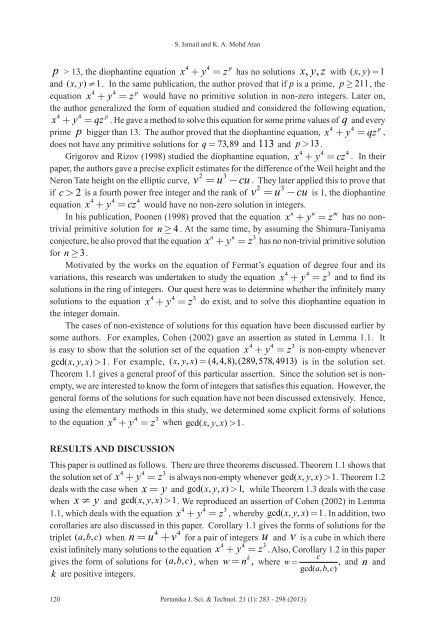JST Vol. 21 (1) Jan. 2013 - Pertanika Journal - Universiti Putra ...
JST Vol. 21 (1) Jan. 2013 - Pertanika Journal - Universiti Putra ...
JST Vol. 21 (1) Jan. 2013 - Pertanika Journal - Universiti Putra ...
You also want an ePaper? Increase the reach of your titles
YUMPU automatically turns print PDFs into web optimized ePapers that Google loves.
S. Ismail and K. A. Mohd Atan<br />
4 4 p<br />
p > 13, the diophantine equation x + y = z has no solutions xyz , , with ( xy= , ) 1<br />
and ( xy¹ , ) 1.<br />
In the same publication, the author proved that if p is a prime, p ³ <strong>21</strong>1,<br />
the<br />
4 4 p<br />
equation x + y = z would have no primitive solution in non-zero integers. Later on,<br />
the author generalized the form of equation studied and considered the following equation,<br />
4 4 p<br />
x + y = qz . He gave a method to solve this equation for some prime values of q and every<br />
4 4 p<br />
prime p bigger than 13. The author proved that the diophantine equation, x + y = qz ,<br />
does not have any primitive solutions for q = 73,89 and 113 and p > 13.<br />
4 4 4<br />
Grigorov and Rizov (1998) studied the diophantine equation, x + y = cz . In their<br />
paper, the authors gave a precise explicit estimates for the difference of the Weil height and the<br />
2 3<br />
Neron Tate height on the elliptic curve, v = u - cu . They later applied this to prove that<br />
2 3<br />
if c > 2 is a fourth power free integer and the rank of v = u - cu is 1, the diophantine<br />
4 4 4<br />
equation x + y = cz would have no non-zero solution in integers.<br />
n n m<br />
In his publication, Poonen (1998) proved that the equation x + y = z has no nontrivial<br />
primitive solution for n ³ 4 . At the same time, by assuming the Shimura-Taniyama<br />
n n 3<br />
conjecture, he also proved that the equation x + y = z has no non-trivial primitive solution<br />
for n ³ 3.<br />
Motivated by the works on the equation of Fermat’s equation of degree four and its<br />
4 4 3<br />
variations, this research was undertaken to study the equation x + y = z and to find its<br />
solutions in the ring of integers. Our quest here was to determine whether the infinitely many<br />
4 4 3<br />
solutions to the equation x + y = z do exist, and to solve this diophantine equation in<br />
the integer domain.<br />
The cases of non-existence of solutions for this equation have been discussed earlier by<br />
some authors. For examples, Cohen (2002) gave an assertion as stated in Lemma 1.1. It<br />
4 4 3<br />
is easy to show that the solution set of the equation x + y = z is non-empty whenever<br />
gcd( xyx> , , ) 1.<br />
For example, ( xyx= , , ) (4, 4,8),(289,578, 4913) is in the solution set.<br />
Theorem 1.1 gives a general proof of this particular assertion. Since the solution set is nonempty,<br />
we are interested to know the form of integers that satisfies this equation. However, the<br />
general forms of the solutions for such equation have not been discussed extensively. Hence,<br />
using the elementary methods in this study, we determined some explicit forms of solutions<br />
4 4 3<br />
to the equation x + y = z when gcd( xyx> , , ) 1.<br />
RESULTS AND DISCUSSION<br />
This paper is outlined as follows. There are three theorems discussed. Theorem 1.1 shows that<br />
4 4 3<br />
the solution set of x + y = z is always non-empty whenever gcd( xyx> , , ) 1.<br />
Theorem 1.2<br />
deals with the case when x= y and gcd( xyx> , , ) 1, while Theorem 1.3 deals with the case<br />
when x¹ y and gcd( xyx> , , ) 1.<br />
We reproduced an assertion of Cohen (2002) in Lemma<br />
4 4 3<br />
1.1, which deals with the equation x + y = z , whereby gcd( xyx= , , ) 1.<br />
In addition, two<br />
corollaries are also discussed in this paper. Corollary 1.1 gives the forms of solutions for the<br />
4 4<br />
triplet ( abc , , ) when n= u + v for a pair of integers u and v is a cube in which there<br />
4 4 3<br />
exist infinitely many solutions to the equation x + y = z . Also, Corollary 1.2 in this paper<br />
k<br />
c<br />
gives the form of solutions for ( abc , , ) , when w= n , where w = , and n and<br />
gcd( abc , , )<br />
k are positive integers.<br />
120 <strong>Pertanika</strong> J. Sci. & Technol. <strong>21</strong> (1): 283 - 298 (<strong>2013</strong>)





